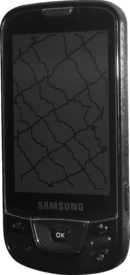Samsung Galaxy (original)
 | |
|
Samsung Galaxy GT-I7500 | |
| Manufacturer | Samsung |
|---|---|
| Compatible networks | HSDPA (3.5G) 900/1700/2100, Quad band GSM / GPRS / EDGE GSM 850, GSM 900, GSM 1800, GSM 1900, |
| First released | June 2009 |
| Successor |
Samsung Galaxy Spica/Lite Samsung Galaxy S (direct) |
| Form factor | Candybar |
| Dimensions | 115 mm × 56 mm × 11.9 mm |
| Weight | 114 g |
| Operating system |
Android v1.6 (Donut) Originally Android 1.5 Upgradable to Android 2.3 unofficially[1] |
| CPU | ARM11 528 MHz + DSP 256 MHz |
| Memory | 128 MB RAM |
| Storage | 8 GB |
| Removable storage | MicroSD support for up to 32GB |
| Battery | Li-Ion (1500 mAh) |
| Data inputs | Touchscreen |
| Display | 320 x 480 px, 3.2 in, AMOLED, Touchscreen |
| Rear camera | 5 Megapixels with flash |
| Connectivity | USB 2.0, Bluetooth 2.1, Wi-Fi b/g, GPS |
The Samsung Galaxy, known as Samsung GT-I7500 in some countries, is a mobile phone manufactured by Samsung that used the open source Android operating system. It was announced on 27 April 2009.[2] It is succeeded by the Samsung i5700.
Features
The Galaxy is a 3.5G smartphone, offering quad-band GSM and announced with tri-band HSDPA (900/1700/2100) at 7.2Mbit/s (however, Samsung's official pages for the Danish,[3] Finnish,[4] Norwegian[5] and Swedish[6] versions only mention dual-band UMTS 900/2100). The phone features a 3.2-inch AMOLED capacitive touchscreen, a 5 megapixel autofocus camera with power LED flash, and a digital compass. Unlike the first Android phone, the HTC Dream (the G1), the i7500 has a standard 3.5mm headphone jack,[7] and a Directional Pad in place of a trackball.[8]
Software-wise, the Galaxy offers a suite of Mobile Google services, including Google Search, Gmail, YouTube, Google Calendar, and Google Talk. The phone's GPS enables Google Maps features such as My Location, and Google Latitude. It also supports MP3, AAC (including iTunes Plus downloads) (only the codec, not the .aac format), and H.264 video.[9] A beta version of the Spotify music streaming service is also now available for this phone via the Android Marketplace.
Criticism
Due to a lack of firmware updates Samsung has received a lot of criticism from Galaxy users.[10]
For some countries, Samsung has updated the Galaxy's firmware to Donut (1.6). Users from other countries can download and update it manually (which will void the warranty). Drakaz, a developer who has been working on getting Android v1.6, v2.2 and v2.3 to work on the i7500 for some time has made some improvements.[11]
See also
References
- ↑ "GAOSP - unofficial port of Android 2.2 for the I7500". Code.google.com. Retrieved 2010-12-16.
- ↑ "Samsung launches I7500, the company's first Android-powered mobile phone". Innovator.samsungmobile.com. Archived from the original on 2012-05-02. Retrieved 2010-12-16.
- ↑ "Samsung Galaxy - Danish". Samsung.com. Retrieved 2010-12-16.
- ↑ "Samsung Galaxy - Finnish". Samsung.com. Archived from the original on 2010-08-19. Retrieved 2010-12-16.
- ↑ "Samsung Galaxy - Norwegian". Samsung.com. Archived from the original on 2011-06-16. Retrieved 2010-12-16.
- ↑ "Samsung Galaxy - Swedish". Samsung.com. Archived from the original on 2011-06-16. Retrieved 2010-12-16.
- ↑ Tuesday, April 28, 2009 (2009-04-28). "Samsung launches its first Android phone - the i7500". Pocket Picks. Archived from the original on 2009-08-18. Retrieved 2010-12-16.
- ↑ "Samsung Galaxy i7500 Preview". Phone Arena. Archived from the original on 2010-01-06. Retrieved 2010-12-16.
- ↑ Lanxon, Nate (2009-04-27). "CNET: Forget swine flu: Samsung i7500 Android phone is official". Crave.cnet.co.uk. Archived from the original on 2010-03-30. Retrieved 2010-12-16.
- ↑ http://www.theregister.co.uk/2009/12/30/galaxy_android_2/ Archived January 5, 2014, at the Wayback Machine.
- ↑ "Upgrade firmware of Samsung Galaxy by Drakaz". Drakaz. Archived from the original on 2013-05-14.
External links
| Preceded by None |
Samsung Galaxy 2009 |
Succeeded by Samsung Galaxy Spica Samsung Galaxy S |

